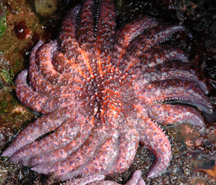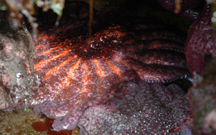
![]()
Sunflower Star (Pycnopodia helianthoides)
Other names: sunflower starfish, twenty-rayed star.
Photo 1: Sunflower star at low tide.
This starfish is quite common in the intertidal zone. Typically this sea star has 20 arms but may have more. It is the largest starfish in the world. (Taken at Shelter Point Reef)
Photo 2: Sunflower star in a crevice.
Sunflower stars are incredibly flexible (or mushy if you like). This flexibility gives them great speed. They can move faster than 1 meter per minute. They coast over the reef faster than any other sea stars.
(Taken at Shelter Point Reef)
Photo 3: A pair of sunflower stars.
Sunflower stars are voracious eaters. They eat just about anything including other sea stars. Fortunately for a lot of creatures, a sunflower star cannot venture into the mid to high tide zones because their soft body structure requires water to support it. (Taken at Shelter Point Reef)



Other Pacific Northwest Sea Stars: Blood Star, Leather Star, OchreStar, Six-rayed Sea Star
